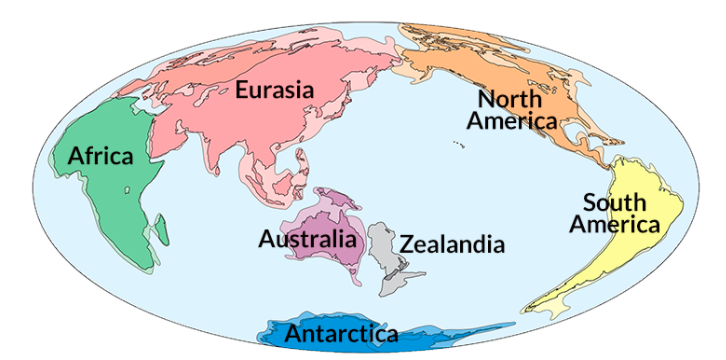Zealandia, The 8th Continent
December 31, 2021
You probably are freaking out from excitement after reading the title. A new continent full of possibilities and opportunities! What amazing news! Unfortunately, this Zealandia will not be the saving grace from moving to Mars due to climate change. This 4.5 million square kilometer landmass is 95% submerged underwater.
Also named the “Lost Continent”, Zealandia is located east of Australia and the remaining 5% make up modern New Zealand, New Caledonia, and other small islands. It used to be a part of the supercontinent Gondwanaland (South America, Africa, Arabia, Madagascar, India, Australia, and Antarctica), but broke apart 80 million years ago.
Although it was first found in 1990s, the debate is ongoing whether this landmass should be considered the 8th continent. Due to its mammoth size, Zealandia is argued by some scientists that it should be added to our list of continents because the facts are (literally) too large to ignore.
At one point in geologic history, Zealandia used to be a part of Austrailia and above sea level before it separated and submerged underwater in the Pacific; it is completely made up of continetal crust. However, due to how oceanic crust is denser than continental crust, Zealandia is raised 1 kilometer higher than surrounding oceanic crust.
Nick Mortimer, a geologist at the Geological and Nuclear Sciences and co-author of “Zealandia: Earth’s Hidden Continent”, gave a simple analogy to describe the circumstances of Zealandia: ““If we could pull the plug on the world’s oceans, it would be quite clear that Zealandia stands out. If it wasn’t for the ocean level, long ago we’d have recognized Zealandia for what it was — a continent.”
Let’s have a look at more criteria when catergorizing a continent that were outlined by Mortimer in the “Zealandia: Earth’s Hidden Continent”:
- Must be continental crust (Zealandia is made up of continental crust)
- Roughly one million square kilometer area (Zealandia is 4.9 million square kilometer)
- Elevation above ocean floor (Zealandia is around 1 km above the ocean floor)
- Crust of continent must have a mix of igneous, sedimentary, and metamorphic rock (Check!)
- Must be of continental size of bigger than 1 million square kilometers (Yep!)
Zealandia seems to be checking off all the boxes, however, its debate highlights one thing: there is no clear definition of what a continent is. All of these qualifications have been published by Mortimer and his research crew, but many scientists argue on the size a continent must be or whether its landmass that is submerged underwater can be considered part of the continent. For example, Zealandia is bigger than the largest island of Greenland but also smaller than the smallest continent of Austrailia; all of them are bigger than one million square kilometers.
Katy Gorden, a senior at Hills, says she disagrees: “Zealandia is not even above water. I don’t understand how it can be called a continent when all the other ones we have established have more than half of the landmass is above sea level. Although it is made from continental plate, I don’t think its worth it to start putting Zealandia on maps and confuse the public.”
Furthermore, there are still debates as to how many continents there are. The conventional answer is seven, but there are answers such as six which include the Americas, Asia, Europe, Antartica, Austrailia, and Africa; five which group Asia and Europe into Eurasia; or four which group Asia, Europe, and Africa into Afro-Eurasia.
But what do you think? How many continents are there? Should Zealandia be the 8th continent?







